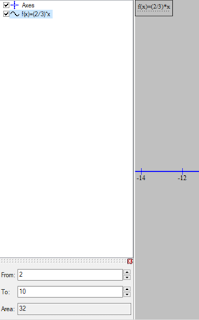For y = (2/3)*x
The integral:
Thus, setting C = 0
100/3 - 4/3 = 96/3
= 32
Applying the theorem,
v = 1/(10 - 2) * 32
= 4
The average value is 4.
True, by just looking at our function at its midpoint on the x-axis, 6
(2/3)*6 = 4
Not a proof, but certainly a demonstration
* * *
4 = (x^2)/3
x^2 = 12
= 4 * 3
x = ± 2*3^.5
= 3.464
* * *
I thought at first that complex numbers might facilitate life
with square, cubic...n roots. After all, a complex number always
has at least one root: that is the Fundamental Theorem of Algebra
(which made Gauss famous). Turns out nope, because these roots
are still dangerous. Consider:
(-2)^3 = -8 so that
(-8)^1/3 = -2, is its only root. Fine and good.
But if one starts to work with this, one might find that
source: German-laguage Wikipedia
In terms of current work in mathematics, complex roots
are studied on Riemann surfaces (named in honor of
Riemann).








No comments:
Post a Comment